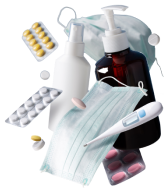Healthwire Pharmacy provides 100% genuine medicines straight to your doorstep.
Order Now! & Avail
Upto 10% OFF On All Your Pharmacy Orders!
Healthwire Pharmacy Ratings & Reviews (1500+)
Product Information
The mechanism of action of SPF 30 cream primarily involves the absorption and scattering of ultraviolet (UV) radiation from the sun. The active ingredients in SPF 30 creams typically include chemical UV filters or physical blockers, or a combination of both. Chemical UV filters work by absorbing UV rays and converting them into heat energy, which is then released from the skin. Common chemical filters may include avobenzone, octinoxate, and oxybenzone. These compounds selectively absorb UV radiation, primarily in the UVB range (290-320 nm) and to some extent, UVA rays (320-400 nm). Physical blockers, such as titanium dioxide and zinc oxide, act as reflective barriers, scattering and reflecting UV rays away from the skin. These particles sit on the surface of the skin and create a protective shield, preventing UV radiation from penetrating the deeper layers of the skin. The effectiveness of SPF 30 cream is attributed to its ability to reduce the amount of UV radiation reaching the skin, thereby minimizing the risk of sunburn, premature skin aging, and potential skin damage caused by prolonged exposure to UV rays.
Sunscreen.
Cream
The following are the uses of SPF 30 Cream:
In the case of an overdose of SPF 30 cream, it is important to recognize that this is a topical product and not a medication intended for ingestion. While it is generally safe for external use, excessive application may lead to skin irritation or discomfort. If ingested in large quantities, it could potentially cause gastrointestinal issues. If you suspect an overdose, particularly in children, contact a healthcare professional or poison control center for guidance and further instructions.
In the case of a missed dose of SPF 30 cream, it is important to apply the cream as soon as you remember. However, if it is almost time for your next application, skip the missed dose and continue with your regular schedule. Do not apply extra sunscreen to make up for the missed dose, as this may increase the risk of skin irritation or sensitivity. It is crucial to maintain a consistent application schedule to ensure maximum protection from the sun's harmful rays. If you frequently miss doses, consider setting reminders or keeping the sunscreen in a visible location to prompt regular use.
To apply SPF 30 Cream, gently massage a generous amount onto your skin, covering all exposed areas, at least 15-30 minutes before sun exposure, and reapply every two hours or after swimming or sweating to maintain protection.
Here are the situations or conditions when SPF 30 cream should not be used:
The side effects of SPF 30 Cream may include:
Following are the precautions and warnings for SPF 30 Cream:
Following are the drug interactions for SPF 30 Cream:
Following are the food interactions to consider with SPF 30 Cream:
Store SPF 30 Cream in a cool, dry place, preferably at room temperature, ensuring it's away from direct sunlight, heat, and moisture. Keep the cream tightly sealed in its original packaging to maintain its integrity and prevent contamination. Pay attention to the expiration date, and when disposing of the cream, do not flush or pour it down the drain. Instead, consult a pharmacist or healthcare professional for safe disposal practices to protect the environment. Always keep the cream out of children's reach to prevent accidental exposure or ingestion. Proper storage and disposal practices are crucial for the effectiveness and safety of SPF 30 Cream.
Following are the quick tips for SPF 30 Cream:

Order Now! & Avail
Upto 10% OFF On All Your Pharmacy Orders!

If you face any issue, feel free to contact us. We provide 24/7 support to assist your problems